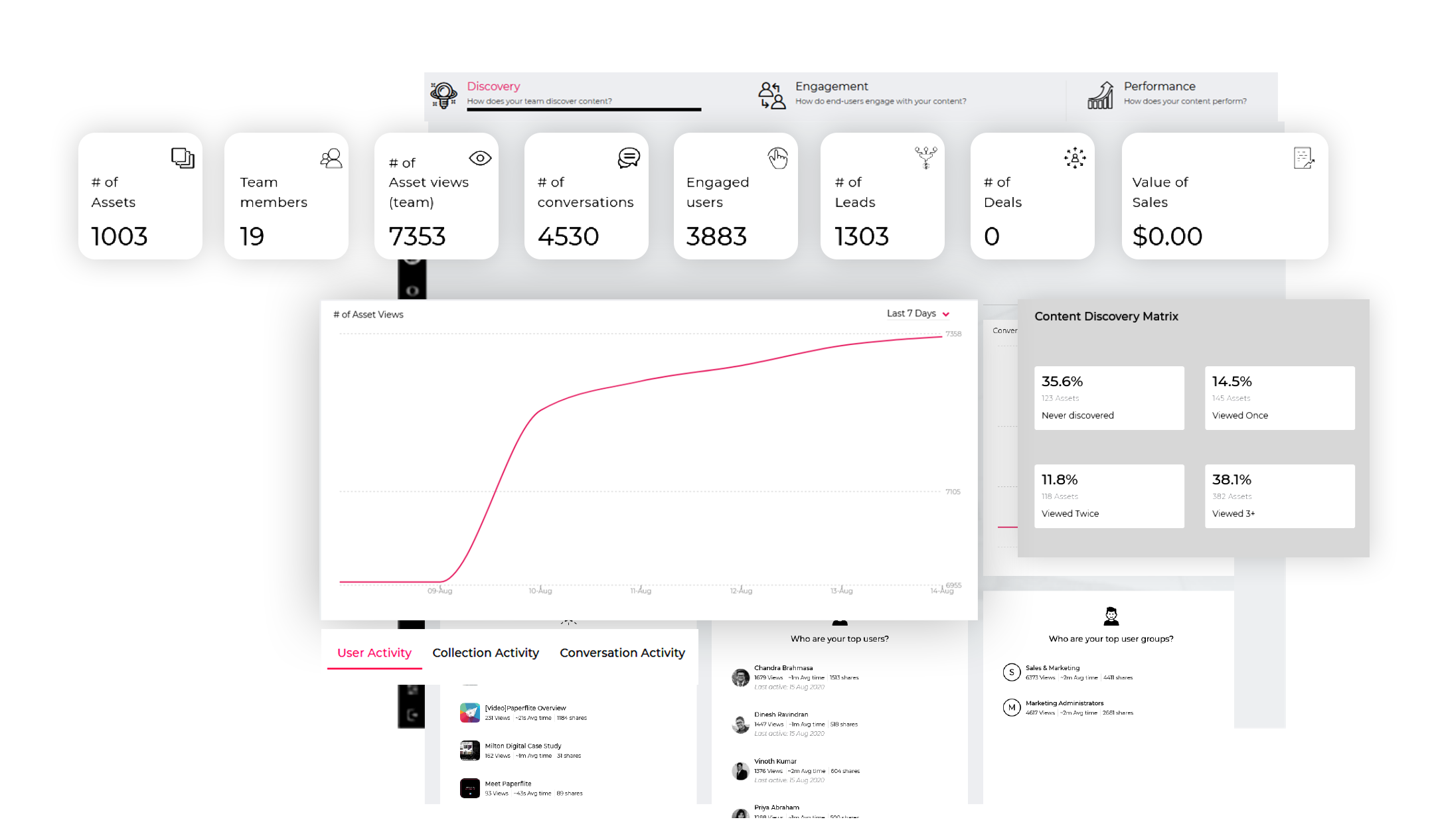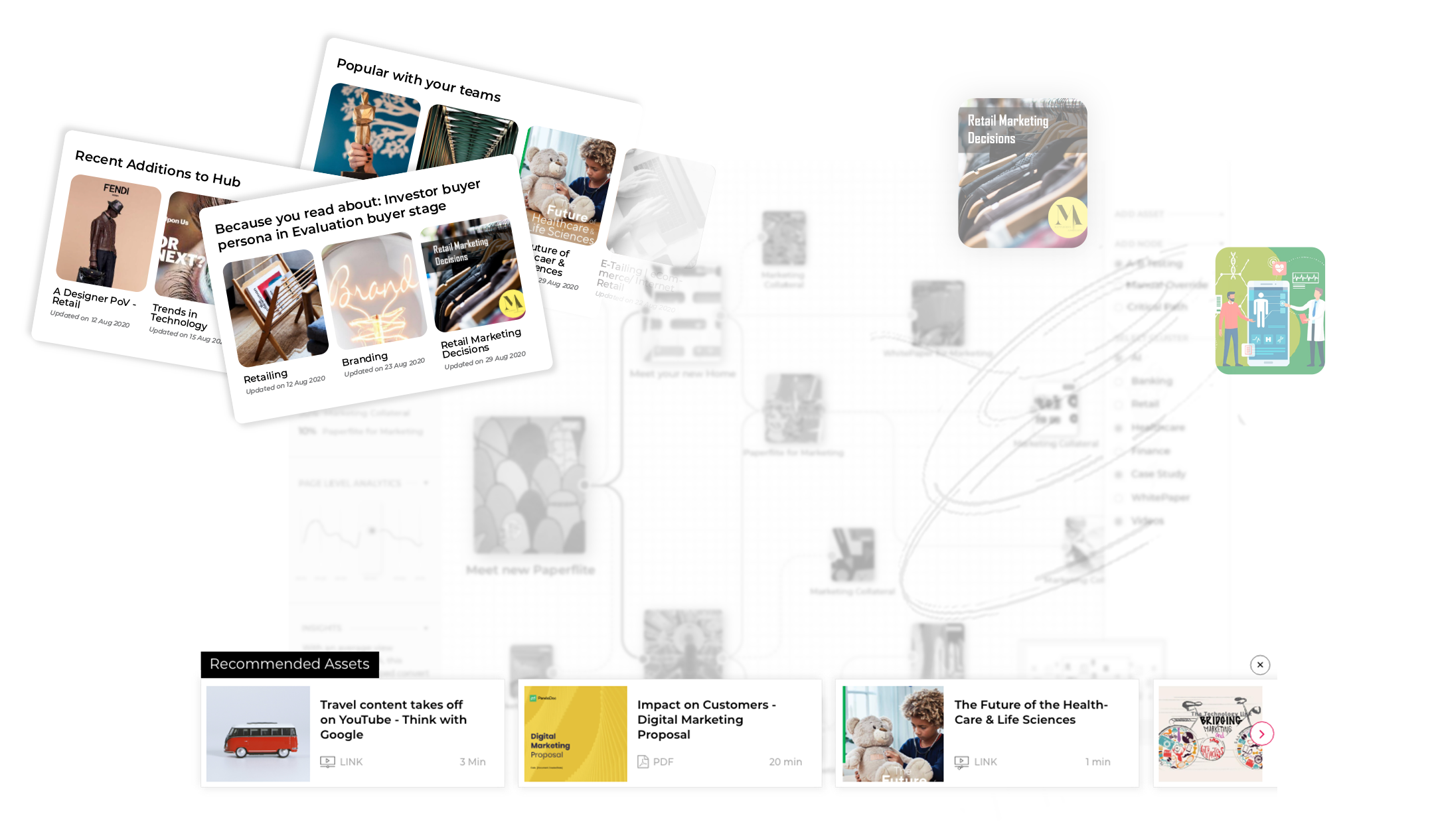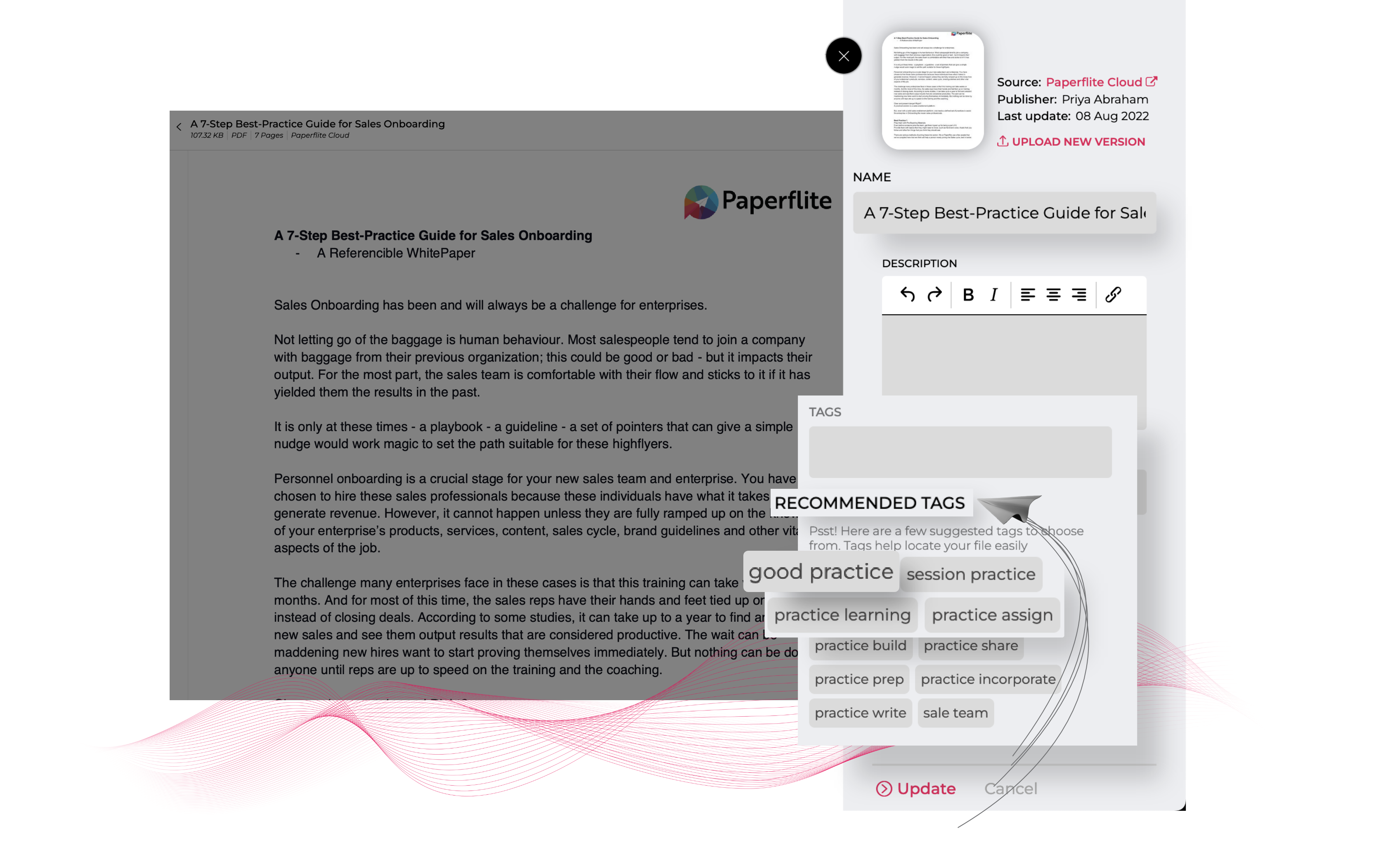What is Content Discovery and why do you need it?
Imagine hiring 5 people for your sales team, but only 4 show up to perform their roles because the last one is searching for content. Not very Cash Money of the process, right?
Let’s hypothesise a bit.
Say you’re in the sales team of a company with a dearth of content. Too many existing sales and marketing collaterals pieces to count, with more being churned out on the daily.
Now, say you need a specific document that you’re “pretty sure that you remember hearing about” regarding sales onboarding. Surely it’s gotta be somewhere within your CMS……right?
Let There Be No More Content Scavenger Hunting
So here’s how anyone, especially newer team members, would logically go about it.
Step 1: Ask Manager.
Step 2: Ask the marketing team because the Manager himself isn’t too sure.
Step 3: Search for it yourself by digging through your content library.
Step 4: Waste time and energy only to assume it doesn’t exist and give up.
(Many moons later)
Step 5: Find it while looking for something else.
That’s a lot of time, effort and frustration involved for something that should be done within seconds. Here’s where ✨Content Discovery✨ comes in handy to keep things at your fingertips.
What Is Content Discovery?
Content discovery refers to the process of finding and accessing relevant information or resources. This could include documents, data, or digital assets stored across various platforms or databases within a company.
Within the scope of content management, content discovery is crucial because it ensures that employees can find the information they need, when they need it, quickly and efficiently.
Imagine having your Sales team, for instance, slowed down in performing their role because they’re unable to find data on time. Not very cost-efficient of the process, is it?

Well, content discovery comes to the rescue, enhancing speed and productivity by saving time and effort in searching for specific resources. It plays a key role in maintaining an organized and efficient content management system, ultimately supporting your organisation’s processes and goals.
Why Should Content Be Discovered?
A significant portion of content that exists within organisations often remains underutilized and thus, fails to reach its full potential. According to a McKinsey report, this is what happens when a team ends up spending 1.8 hours every day (9.3 hours per week, on average) searching for information and assets in futility.
However, by harnessing content discovery, organisations can save considerable time and effort and fully leverage all their valuable resources. Talk about a double win!
According to Veena Gowda, Global Marketing Manager at global technology services firm, Aspire Systems, after implementing content discovery strategies, it now takes her team less than 3 minutes to find and share all the relevant collateral they need. All of this time saved cumulatively translates to about $84k in savings for each sales rep. EACH of them!
If this doesn’t have you sold already, here are more reasons why your company should’ve been utilising content discovery by yesterday!
1. Enhanced Content Utilization:
By implementing a content discovery matrix, identifying content that’s popular with your team, and tracking elements such as their most used tags and searched queries, you keep content at the users’ fingertips. These approaches guarantee that valuable resources are always identified, accessed, and utilised efficiently.

2. Informed Decision-Making:
Content discovery propels data-driven content strategies. When your team can easily access information, it makes it possible to build effective strategies around said information.
In addition, content discovery improves content governance. You or your team heads can monitor who views, downloads, shares, and accesses what content, as well as conversation activity and the number of assets and collections created.
This sort of convenience and oversight empowers your organisation via informed decisions and management.
3. Efficient Content Production:
Content discovery also enables your team(s) to obtain data-driven insights. This can save you even more time and resources by enabling you to create an efficient content calendar and offering an effective guide for your content optimization efforts. By this, your organisation can meet content demands more effectively.
What Are the Types of Content Discovery?
There are different types of content discovery. The types also vary for B2B and B2C organisations. Here are three of them:
1. Search-Based Content Discovery: requires users to actively search for specific content by using keywords, phrases, or other search criteria. Examples include SEEK and Paperflite for B2B content-based search, and Google search—which is commonly used for a wide range of keyword purposes.
2. Content Aggregation-Based Content Discovery: organises content from various sources into a centralised repository, making it easier for users to find relevant information. Examples include Cleverstory’s service for B2B companies and Flipboard which runs a B2C model.
3. Recommendation-Based Content Discovery: utilises algorithms and user behaviour analysis to suggest content to users based on their preferences, interactions, and other aggregated data. Examples include AI-driven content recommendations like those seen on Amazon and Spotify (B2C). Paperflite also employs similar techniques.

Identifying the “Content Effort vs. Usage” Gap.
The two main groups of people that benefit directly from content discovery tools are your employees and your audience (aka potential customers).
Under the former, most Sales teams never know that internal content or resources exist which align perfectly with their prospects. This is often due to inaccessibility, inability to find these assets on time, or simply because they did not know that content existed to begin with.
Statistics reveal that Sales teams spend an average of 440 hours each year trying to find the right content to share with their prospects and customers. That’s almost 9 working hours every week! And most of the time, they remain unable to find the content they need.
The most common reasons for this inaccessibility which leads to high levels of unutilized or underutilized content are:
- Poor searchability;
- Lack of awareness; and
- Content overload.
For any employee, especially the Sales folks, TIME IS MONEY.
Time wasted is revenue lost and money left on the table. A single market research study costs between $20,000 to $50,000, and large firms can end up spending millions on enterprise data and market research per year.
However, unutilized data due to wasted time searching for information equates to $1.7 million lost per year for every 100 employees in US organisations.
See why content discovery is so crucial?
Strategies to Address Underused Content.
The best solution to underutilisation of content is content discovery metrics. These metrics give your company a clear report of which collaterals have performed the best and which are the most popular.
Content inventory and audit enable systematic review and cataloguing of existing content so you can identify underused content. It also enables your team to understand how content can be updated, repurposed, or better promoted for effective use.
Implementing content recommendation systems brings in the use of algorithms to analyze user behaviour and preferences. Your underused content can then be recommended to users who will find it valuable.
How Content Discovery Aids in Content Creation.
1. Data-Driven Insights: Content discovery uses analytics to give insights and recommendations by tracking the most searched queries and user engagement patterns, such as time spent on content, the number of viewers, shares, asset views, and areas where users spend the most time.
2. Streamlining Content Research: Content discovery employs AI-powered search and tagging, including auto-tag recommendations for assets. It also enhances collaboration through features that support content creation and live content collection.

3. Improving Content Relevance: Content discovery applies personalisation and user segmentation to suggest content that is the most relevant to the searcher’s needs. This ensures that content meets the specific requirements of the person looking for it.
Tools for Content Discovery.
The leading tools for content discovery include:
Paperflite:
Paperflite revolutionizes content repositories, offering a dynamic and personalized discovery experience by combining structured content streams with intelligent recommendations. It's SmartSearch algorithm ensures efficient content retrieval, inspired by Google search and Amazon filters, allowing sellers to find the most relevant content quickly.
Administrators can granularly manage content access, tailoring it to territories, products, or services. This prevents content overload and provides a personalized experience for each user.
Key Features of Paperflite in Content discovery:
- AI-Driven Content Recommendations: Machine learning powers Paperflite's content recommendations, considering reps' consumption patterns, top-performing sellers' success, and materials proven to close deals.
- Seamless Integration and Syncing: Seamlessly integrates with content storage platforms like SharePoint and Google Drive, offering a unified library accessible from one central location.
- In-App Editor Capabilities: In-App editor empowers reps to edit templates within the platform, streamlining content creation and customization.
Flipboard:
Flipboard is a content aggregation app that curates news, articles, and stories tailored to the user’s interests, presenting them in a magazine-like format. The app personalises the content discovery process, making it easy for users to stay informed and find engaging content in their areas of interest, thereby enhancing user engagement and satisfaction.
Flipboard’s algorithm leverages AI to curate and personalise content feeds for its users.
ContentStudio:
ContentStudio is a content marketing and social media management platform that assists businesses in discovering, planning, publishing, and analyzing content across various social channels. The platform streamlines the content creation and distribution processes, making it easier for brands to maintain a consistent presence online and engage their audience effectively.
Its key features include a content calendar, as well as content analytics and automation tools, which collectively enhance content strategy and execution. ContentStudio also offers an AI Writer tool which helps users instantly generate captions and images.
Feedly:
Feedly is an AI-powered news aggregator application that compiles news feeds from a variety of online sources. This makes it a crucial tool for individuals and professionals seeking to stay informed about industry trends and topics of interest.
With Feedly, users can subscribe to their favourite blogs, news sites, and other content sources, organising all these feeds into a single, easy-to-navigate interface.
Hootsuite:
Hootsuite is another social media management platform that enables brands and individuals to schedule posts, manage multiple accounts, and engage with audiences across different social networks from a single dashboard. It helps streamline social media strategies, saving time and improving efficiency by allowing users to monitor and manage their online presence effectively.
It also offers features such as analytics to track performance, social media monitoring to discover trending topics and conversations, and team collaboration tools. Hootsuite also integrates open AI tech.
Important Features of Content Discovery
1. Content Recommendation Algorithms: For instance, Paperflite’s content recommendation algorithm feature leverages user history and engagement analytics to suggest the most relevant and impactful content to users.
2. Search and Filter Capabilities: An effective content discovery tool should offer several search filters, including categories, tags, groups, descriptions, metadata, etc.
3. AI-Driven Content Tagging: AI content tag recommendations automatically categorise content, making it easier and faster for users to find relevant and related resources.
4. Integration with Content Creation and Distribution Platform: This is important because it streamlines all the processes of content creation, discovery, and distribution.
5. Content Alerts: For example, Paperflite has an in-platform asset promotion feature which notifies users of new, relevant, or related content based on their user history and preferences.
Content Challenges and Solutions.
1. Content Overload: The problem of information fatigue in content management arises from an overwhelming volume of content, leading to difficulty in managing and utilizing it effectively. The solution is to implement strategies for content prioritization, which will help to focus on the most valuable and relevant content.
2. Content Discovery Metrics: Understanding and improving content discovery begins with identifying Key Performance Indicators (KPIs) for tracking success and effectively interpreting analytics for continuous improvement. These provide your company with deeper insights into user engagement and content performance.
3. Content Governance and Compliance: To ensure that content discovery aligns with regulations, you organisation must implement content management strategies that prioritize compliance.
FAQs.
How do content discovery algorithms work, and can they be customized for my specific needs?
Content discovery algorithms leverage user behaviour, content history, and engagement analytics to recommend the most relevant and useful content. These algorithms are programmed for personalization, so their recommendations will always meet your specific needs.
How can AI-driven recommendations benefit my organization?
AI-driven recommendations can significantly benefit your organisation by personalising your customers’ experiences, enhancing content relevance, and increasing engagement. This targeted approach not only boosts your user interaction but also streamlines content discovery, optimising your organisation’s resource use and potentially driving higher conversion rates.
What is the difference between content discovery and content curation?
Content discovery is the process of finding and accessing relevant content from within your company’s existing collaterals, typically based on user preferences or search criteria.
Content curation, on the other hand, is the gathering, compilation, and presentation of existing content from other sources. The curated content is usually intended for a specific audience or theme; hence, context or commentary may be added to enhance its value.
Are there any ethical considerations or privacy concerns associated with content discovery and user data collection?
Ensuring users are aware of and consent to data collection and how it’s used.
Collecting only the data necessary for content discovery and avoiding excessive personal information gathering.
Protecting user data from unauthorized access and ensuring robust security measures are in place.
Offering options for anonymity.
Allowing users to opt out of data collection and personalisation features easily.
Adhering to all relevant regulations.
How can personalisation play a role in content discovery?
Personalised content discovery enhances user experiences by providing tailored content that caters to individual preferences, interests, and needs. This significantly improves the relevance and value of the content presented to each user.
Leaving this here
Having access and visibility of content whenever, wherever, and by whoever within a team needs it, solves an underlying problem that usually goes right over people’s heads in content management.
Content discovery streamlines this process of finding and utilising relevant content, thereby significantly boosting productivity and content effectiveness. This further results in improved user engagement, higher conversion rates, and more efficient content utilisation, making its ROI exceptional.
Therefore, we highly recommend that you invest in content discovery tools for enhanced content management within your organisation.
This will help you optimise your content strategies and effectiveness, putting you ahead of the best in your respective market. Reach out to us, and we’ll show you how you can better optimise your content discovery process.
